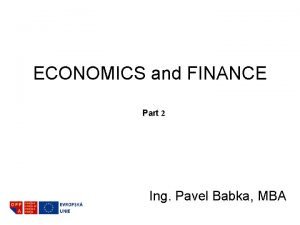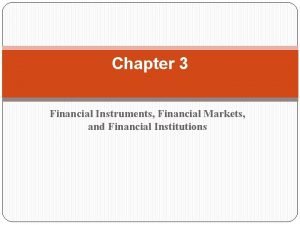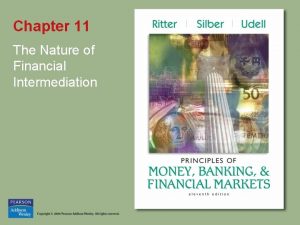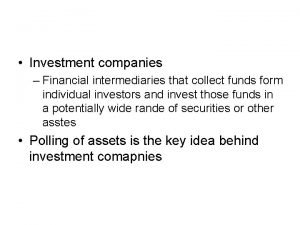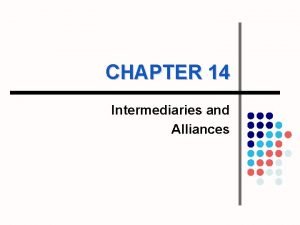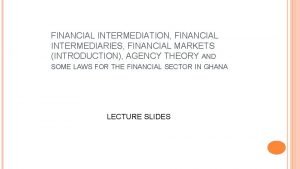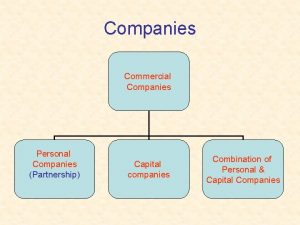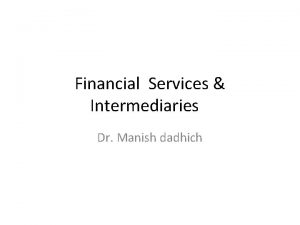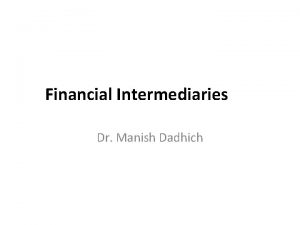Investment Companies Investment companies are financial intermediaries that







- Slides: 7

Investment Companies Investment companies are financial intermediaries that sell shares to the public ad invest the proceeds in a diversified portfolio of securities. 3 types of investment companies 1. 2. 3. Open end-funds Closed end-funds Unit trusts Open-End funds (Mutual Funds) referred to as mutual funds are portfolio of securities, mainly stocks, bonds and money market instruments. a. Investors in mutual funds own a pro rata share of the overall portfolio. b. the investment manager of the mutual find actively manages the portfolio, that is buys some securities and sells others. c. The value of the security is measured as NAV-Net asset value. d. The NAV or price of the security is measured only once each day, at the close of the day. Business publications provide the NAV each day in their mutual fund table. e. all new investments into the fund or withdrawal from the fund during a day are prices at the closing NAV.

Closed–End funds These are very similar to the shares of common stock of a corporation. These are initially issued by an underwriter for the fund. And after the issue the number of shares remain constant. After the issue there are no purchases or sale of fund shares as open end funds. The shares are traded on a secondary market, either on an exchange or in the over-the counter market. Investors can buy shares either the time of the initial issue or in the secondary market. Shares are sold only on the secondary market. The price of shares of a closed-end fund are determined by the supply and demand in the market in which these funds are traded. Thus, investors who transact closed-end fund shares must pay a brokerage commission. There are two important differences between open-end funds and closed –end funds. First, the number of shares of an open-end fund varies because the sponsor will sell new shares to investors and buy existing shares from shareholders. Second, by doing so, the share price is always the NAV of the fund. In contrast, closed-end funds have a constant number of shares outstanding, because the fund sponsor will sell new shares to investors (except at the time of new underwriting). Thus the price of the fund shares will be determined by supply and demand in the market.

There are two important differences between open-end funds and closed –end funds. First, the number of shares of an open-end fund varies because the sponsor will sell new shares to investors and buy existing shares from shareholders. Second, by doing so, the share price is always the NAV of the fund. In contrast, closed-end funds have a constant number of shares outstanding, because the fund sponsor will sell new shares to investors (except at the time of new underwriting). Thus the price of the fund shares will be determined by supply and demand in the market.

Closed–End funds A share’s price may be below the NAV because the fund has large built in tax liabilities, and investors are discounting the share’s price for the future tax liability. A funds leverage and resulting tax liability may be another reason for the share’s price trading below NAV. A fund’s share my trade at a premium to the NAV because the fund offers relatively cheap access to and from professional management of stocks in another country about which information is not readily available to small investors. Recently, the Thai and Thai capital funds have been prominent examples of the situation. Under the Investment company act of 1940, closed end funds are capitalized only once. They make an IPO and then shares are traded on the secondary market, just like any corporate stock. The number of shares is fixed at IPO, closed-end funds cannot issue more shares. In fact, many closed-end funds become leveraged to issue new shares.

Unit trusts A unit trust is similar to a closed end fund in that the number of unit certificates is fixed. Unit trusts typically invest in bonds. They differ in several ways from mutual funds and closed-end funds, that specializes in bonds. First, there is no active trading of the bonds in the portfolio of unit trust. Once the unit trust is assembled by the sponsor and turned over to the trustee, trustee holds all the bonds until they are redeemed by the issuer. Typically, the only time the trustee can sell an issue, in the portfolio is if there is dramatic decline in the issuer’s credit quality. Second, unit trusts have a fixed termination date, while mutual funds, and closed-end funds do not. Unit trusts are common in Europe and not common in US. All unit trusts charge a sales commission. The initial sales charge for unit trust ranges from 3. 5% to 5. 5%. When the brokerage firm or bond underwriting firm assembles the unit trust, the price of each bond to the trust also includes dealer’s spread. Under the Investment company act of 1940, closed end funds are capitalized only once. They make an IPO and then shares are traded on the secondary market, just like any corporate stock. The number of shares is fixed at IPO, closed-end funds cannot issue more shares. In fact, many closed-end funds become leveraged to issue new shares.

Costs There are two types of cost borne by the investors in mutual funds. 1. The shareholders fee/ sales charge. This cost is “one time” charge debited to the investor for a specific transaction, such as purchase, redemption or exchange. 2. Annual fund operating expense, usually called the expense ratio, cover’s the funds expenses, imposed annually, largest of which is for invest management. Approaches for distribution Direct distribution/ Passive approach: No intermediary or salesperson is associated to approach client. The client approaches the fund company, in response to some advertisement. No or little advising for investment is provided. Wholesale distribution/ active approach: Distribution occurs visa an agent who provides investment advice and incentives to clients, to make the sale, or actively “make the deal”.

The sales charge for the agent distributed fund is called a load. 1. Front end load: The load is deducted initially “up front”. This load is deducted from the amount invested by client and paid to the agent. Called A shares. 2. Back end load: While the front end load is imposed at the time of purchase of the fund, back end load is imposed at the time fund shares are sold or redeemed. Called B shares. 3. Level loads: are imposed uniformly each year. Called C shares. The most common type of back-end load currently is the contingent deferred sales charge (CDSC). This approach imposes a gradually declining load on withdrawal. For example, a common “ 3, 3, 2, 2, 1, 1, 0”. CDSC approach imposes a gradually 3% load on the amount withdrawn after one year; 3% after the second year, 2% after the third year, and so forth. There is no sales charge for withdrawals after the seventh year.

